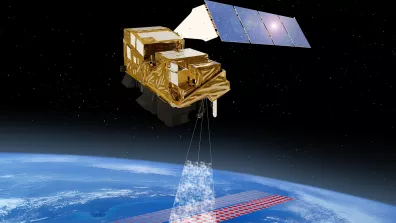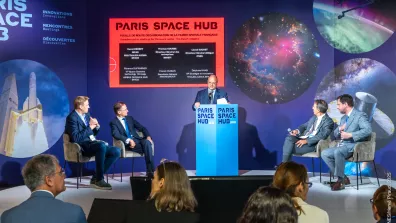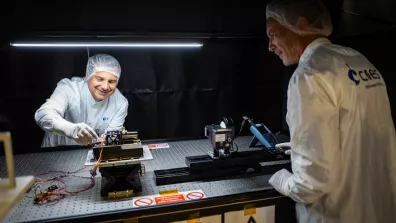The first European space mission dedicated to measuring atmospheric carbon dioxide (CO2), MicroCarb will lift off on the night of 25-26 July from the Guiana Space Centre atop a Vega-C launcher carrying it into its 650-kilometre orbit, where it will cover the surface of the globe every 25 days.
The microsatellite, developed by CNES, has been funded through the French government’s PIA future investment programme with contributions from the European Union and the UK Space Agency (UKSA). It is carrying an infrared spectrometer to analyse sunlight reflected by Earth’s land surfaces and oceans and deduce the proportion of CO2 in the atmospheric column at a pixel size of 4 x 9 sq.km. MicroCarb will thus be able to measure global sources and sinks of carbon and exchanges between them with an accuracy better than one part per million (1 ppm).
Several decades of CO2 measurements
This climatology mission aims to gain new insights into the natural mechanisms involved in CO2 uptake by plants and oceans. It marks a new step forward in research spanning several decades on this greenhouse gas that is naturally present in the atmosphere, but also the main cause of climate change due to man-made emissions fuelled by extensive use of fossil energies.
“The first measurements in the 1950s aimed to find out if this surplus of CO2 was being absorbed or accumulated in the atmosphere,” explains François-Marie Bréon, a climatologist at the LSCE climate and environmental science laboratory and MicroCarb mission principal investigator (PI). “The sensors rigged up by Charles Keeling in Hawaii and Antarctica soon showed that concentrations of the gas, and therefore the impact of human activities on the atmosphere’s composition and climate, were increasing.”
However, these measurements also showed that concentrations were not rising as fast as expected: roughly half of fossil fuel emissions do not end of up in the atmosphere, meaning that the other half is being taken up by natural carbon sinks (see box).
“These sinks are plants, through the process of photosynthesis, which absorbs carbon and releases oxygen, and oceans. But carbon exchanges are being disrupted by the high level of emissions and by deforestation, reducing their absorption capacity,” notes Carole Deniel, Atmospheric Composition & Carbon Cycle subject matter expert at CNES. “With MicroCarb, we’re looking both to better understand these exchanges between sources and sinks, and their seasonality, and to observe how they’re being affected by climate change.”
Space missions since the 2000s
Unlike ground-based stations, which only give a local and very limited picture for lack of sufficient measurement points, space-based remote sensing affords global coverage with high revisit rates, alongside the ability to observe in very fine detail. Several missions were developed in the 2000s to measure atmospheric concentrations of greenhouse gases. The pioneers in this field are GOSAT (Greenhouse Gases Observing Satellite), launched by the Japan Aerospace Exploration Agency (JAXA) in 2009 and 2018, and most recently on 28 June 2025. Almost at the same time, NASA was developing its own programme, with OCO-1 (Orbiting Carbon Observatory), lost on launch in 2009, and OCO-2, successfully orbited in 2014.
Given the go-ahead in 2015 in the wake of the Paris Climate Agreement, after more than 10 years in the study and definition phase, MicroCarb is the successor to these missions and will ensure continuity of OCO-2 data when it reaches the end of its operational life.
“MicroCarb broadly uses the same spectrometer technologies as OCO-2, but has innovated by putting them on a much smaller satellite,” says Philippe Landiech, MicroCarb project leader at CNES. “It’s built around CNES’s Myriade spacecraft bus, of which it’s the 19th and last in the series. The satellite’s no heavier than 180 kilograms, compared to OCO-2’s 800 kilograms. That’s a huge feat of miniaturization, implying very tight space constraints, but the goal is to reduce the satellite’s mass and cost.”
Another technological innovation is the use for the first time ever of a spectral band covering oxygen absorption lines, to correct the CO2 signal for certain dispersive elements like aerosols. “MicroCarb will serve as a demonstrator for this new band,” adds François-Marie Bréon. “We’ll be testing its potential benefits for measurement precision and quality.”
A precursor of CO2M
MicroCarb’s science mission is planned to last five years. After the evaluation phase to compare products with data from other types of ground-based or balloon-borne instruments, data exploitation will begin. “The task will then be to compare them with models and detect any anomalies to refine our knowledge of the relationship between climate and carbon fluxes,” explains our climatologist. “For example, we could try to quantify the impact of a drought or deforestation, or conversely of a tree replanting policy on CO2 fluxes, or how global warming is affecting carbon sinks in Siberia.”
Besides the mission’s science goals and the new data for the international scientific community, MicroCarb is also paving the way for ESA’s future CO2M/Sentinel 7 mission, planned for 2028 as part of Europe’s Copernicus environmental monitoring programme, through the use of common technologies and early adoption of products by users.
Unlike MicroCarb, which is set to measure global carbon fluxes, CO2M will distinguish natural and human-induced emissions. The satellite will be capable of measuring CO2 concentrations at a pixel size on the order of four square kilometres, ten times smaller than MicroCarb, and therefore precisely targeting cities or industrial estates. This operational mission will enable a new step forward in our understanding of climate mechanisms.
Carbon sources and sinks
Carbon exchanges are a natural and constant process between sources releasing CO2 into the atmosphere and sinks absorbing it. Natural sources, like oceans, plant respiration, decomposition of organic matter in soils, wildfires and volcanic activity, account for about 200 gigatonnes (billions of tonnes) of emissions per year. Carbon sinks, on the other hand, are mainly ecosystems such as forests and plankton capturing and storing carbon by photosynthesis, and oceans in which part of CO2 emitted is dissolved. Natural carbon exchanges exhibit seasonal variations, particularly in southern regions of the globe where photosynthesis increases a lot in summer.
Every year, human activities add about 10 gigatonnes of carbon, upsetting this natural balance. Half of anthropogenic (human-induced) sources of carbon, mainly from fossil fuel emissions (nearly 90%) and deforestation, are absorbed by ecosystems. The other half released into the atmosphere inexorably increases concentrations of CO2. As the curve derived from readings started by the American research scientist Charles David Keeling in Mauna Loa shows, concentrations have increased from 320 ppm in the 1950s to 420 ppm, driving the climate disruptions we’re seeing today.






